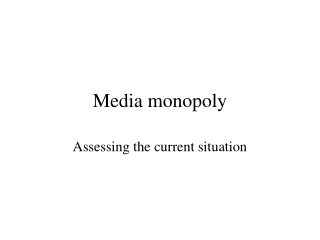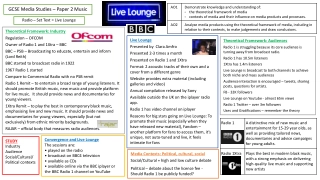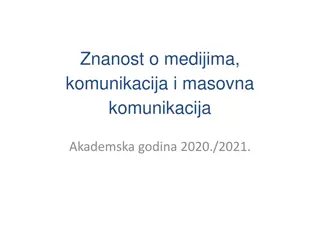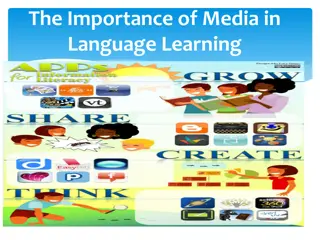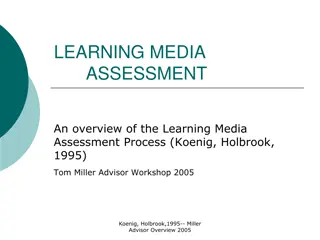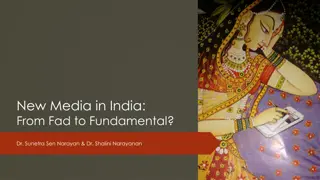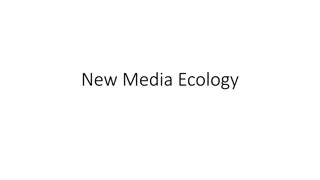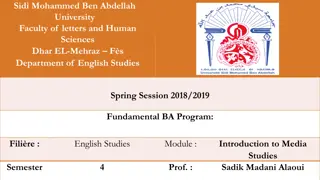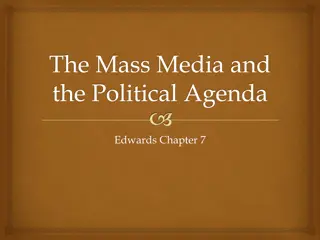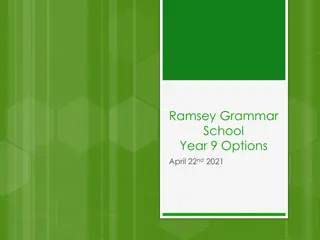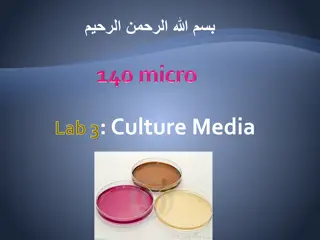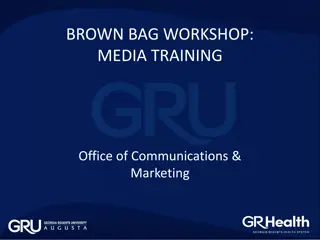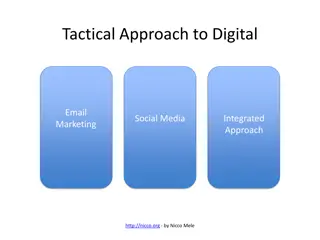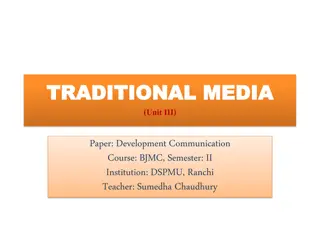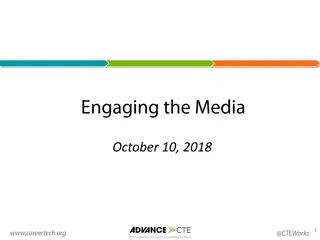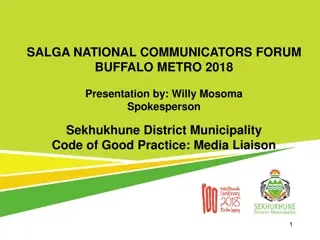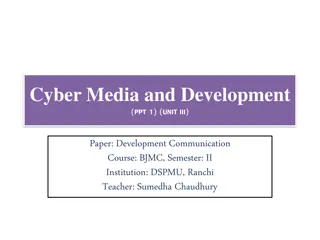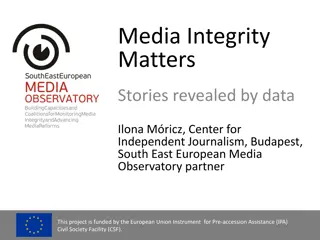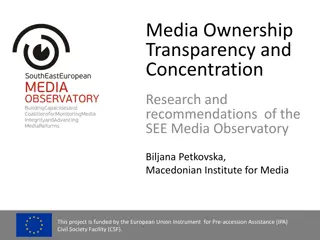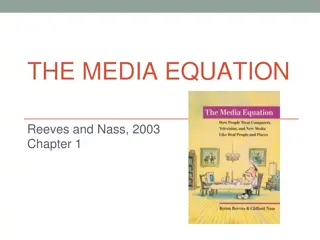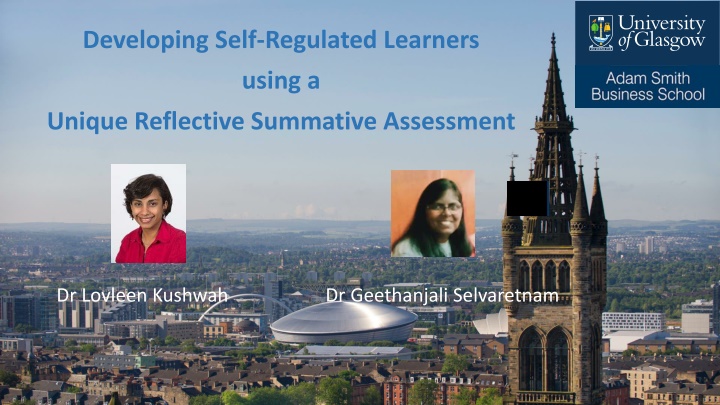
Developing Self-Regulated Learners Through Reflective Summative Assessment
Explore the process of developing self-regulated learners using a unique reflective summative assessment method. Dive into literature on self-regulated learning, assessment design, data collection, and the importance of internal feedback in enhancing student learning outcomes.
Uploaded on | 2 Views
Download Presentation

Please find below an Image/Link to download the presentation.
The content on the website is provided AS IS for your information and personal use only. It may not be sold, licensed, or shared on other websites without obtaining consent from the author. If you encounter any issues during the download, it is possible that the publisher has removed the file from their server.
You are allowed to download the files provided on this website for personal or commercial use, subject to the condition that they are used lawfully. All files are the property of their respective owners.
The content on the website is provided AS IS for your information and personal use only. It may not be sold, licensed, or shared on other websites without obtaining consent from the author.
E N D
Presentation Transcript
Developing Self-Regulated Learners using a Unique Reflective Summative Assessment Dr Lovleen Kushwah Dr Geethanjali Selvaretnam
Structure of Presentation Literature on self-regulated learning (SRL) Motivation and Objective Assessment Design Data collection and methodology Discussion of Findings 2
SelfRegulated Learning is an active constructive process whereby learners set goals for their learning and monitor, regulate, and control their cognition, motivation, and behaviour, guided and constrained by their goals and the contextual features of the environment . - Pintrich and Zusho (2002, p. 64) 3
Some Literature on Self-Regulated Learning Self-regulated learning is a valuable skill to be developed External feedback by teachers or any other source would be futile unless students internalise these. High level feedback which are beneficial for self-regulation and self-evaluation, process are difficult for teachers to give. Self-regulated learning requires students to update their knowledge themselves. Students can generate valuable feedback themselves. Students have to be active learners to develop as self-regulated learners but activities have to be well-thought. [Butler and Winnie (1995), Carless and Boud (2018), Hattie and Timperley (2007), McArthur and Huxham (2013), Sadler (2010), Andrade (2018)]
Some Literature on Self-Regulated Learning To develop SRL skills, students should be given the opportunity to self-generate internal feedback to update learning and evaluate whether they achieve their learning goals. Internal feedback should be made explicit for effective self-regulated learning to happen. Some effective ways to facilitate internal feedback generation involve students comparing their answer with a comparator: o Peer review o Two stage exams (i.e, individual work followed by group work) o Reflect on teacher comments o Looking at learning resources and thinking how their answer could have been improved o .. [Nicol (2020), Nicol and Selvaretnam (2021), Nicol and McCallum (2021), Nicol and Macfarlane-Dick (2006)]
What is our Study about Interlinks formative and summative assessments. Extracts learning while working on a difficult task without overwhelming students. Makes the internal feedback explicit and enables students to realise its importance. Our comparators - expert s video and written solution- are those which students would encounter and use in the future to update their learning. Provides a set of reflective questions and feedback tools. Analyses the effectiveness of this assessment method using qualitative analysis. Adds to the literature on assessments, internal feedback and self regulated learning. 6
Assessment Design Student answers Survey 1 Reflective questions - perception about performance - learning gaps Student completes a task Stage 1 (Formative Assessment) Expert s Written Solution Student answers Survey 2 Reflective questions - what have they learnt Stage 2 Expert s Video Solution Summative Assessment Answers to Survey 1 - Answers to Survey 2
Self-regulated learning process MAKE INNER FEEDBACK EXPLICIT Generate Inner feedback Reflective questions after completing task - perception about performance - learning gaps Compare Student 1 completes a task - Lectures - Reading - Criteria etc. Generate Inner feedback Expert s Written Solution Reflective questions after seeing expert s video and solutions 2 Compare Expert s Video Solution Update knowledge, improve performance.
Task for Lab session 1- Formative Assessment Students were asked to find 3 reliable Macroeconomics data sources Finding data for some of the macroeconomic variables, such as those pertaining to Balance of Payments, Capital accounts and Current accounts. Validate their data using historical data which was provided to them as an example. 9
Survey A Stage 1 How confident are you about your answer in Lab Session 1? Choose the most appropriate one. Closed-ended Had the Lab session 1 questions been graded; would you have done it differently? Explain Open-ended Do you have a clear idea about what was required to produce a good answer? Choose the most appropriate one. Closed-ended What were the positive aspects of your answer, i.e., could you explain what your strengths are? Open-ended If you are aware of any weaknesses in your answer, or if there are aspects of your answer that were still troubling you, could you explain what the issues are. If you could have talked to an expert while writing your answer, what feedback would you have asked for? Explain. Open-ended Maximum 300 words ; 5% of the total assessment grade
Survey B Stage 2 (Maximum 800 words ; 10% of the total assessment grade) Explain how the expert's answer compare with yours. Open-ended Explain whether the expert's video made you aware of any weaknesses or strengths in your answer that you were not aware of at the time you wrote it? Open-ended Can you explain how you would improve your answer now, if you had the opportunity to do so? Open-ended Would you have preferred to have seen the expert's video before attempting the question why? Open-ended How has attempting the exercise before watching the expert's video benefitted your learning? Open-ended Open-ended Do you need any more comments on your own work from the expert now that you have watched the video? What did you learn more generally that will inform your future work? (e.g., about approach, working with data, ways of thinking, writing explanations, or anything else). Explain. Open-ended What did you learn more generally that will inform your future work? (e.g., about approach, working with data, ways of thinking, writing explanations, or anything else). Explain. Open-ended There are several forms of giving feedback to students, for example, individual written feedback, generic written feedback, verbal feedback in classroom etc. Since now you have seen an expert doing the same exercise in a video, what are your thoughts about using such a video as a feedback tool? Open-ended
Data Collection and Methodology Undergraduate Honour Course - International Finance Answers to the two surveys - student reflections1 . End of the course evaluation. Ethics approval has been obtained Only those who consented to be included in the research were chosen - 49 out of 53 students Qualitative analysis: Coding and Thematic analysis 2 [1.Bain et al. (2002), Grossman (2008), Haigh, N. (2000), Mcquire et al (2009), Ryan (2015) ] 12 [2. Braun and Clark, 2006; Mcquire and Delahaunt, 2017 ]
Key Findings effect of non-grade When incorporated as part of a summative assessment, non-graded nature of formative assessment had little influence on most of the students choice of effort. - Some students (18) indicated that they would have still taken this formative exercise seriously, however, they would have spent more time and effort in completing the exercise carefully had it been graded. - Remaining students (31) would have still done the same but would have invested more time and done the exercise more carefully. 13
Key Findings effect of non-grade I would have perhaps done it earlier as other work that was graded took priority for me. However, I would not have put in necessarily more effort as I put in a good amount anyway and was happy with my participation in the activity. emphasis on grading would force me to factor in more time more effort. I would also look at what criteria would make an A level answer and try to match this to the best of my ability by using a checklist. 14
Key Findings Benefits to students Students gain clarity of the process of working through practical problems in Economics (26), enhanced their knowledge of the subject (22), research skills (17) and data skills (18). A few students preferred to skip this process (2) and be provided with the answer saving time and effort. More engaged (9) and learnt through challenges (10) Practice previously gained skills (3) and appreciate future applicability (10) Soft Skills such as confidence (3), independence (17) , curiosity (12) , intuition (#TBA), and spontaneity (3) could be developed through activities that focus on process of learning rather than the result. 15
Key Findings Benefits to students This has benefitted my learning as had I seen the expert video beforehand it would have been extremely easy to follow his steps and gain the correct answers. This would be negative for my learning as it would require very little thought, application of research skills or use of intuition on my behalf in order to achieve the desired answers. It reinforced my knowledge on finding the balance of payments and improved my data skills. It allowed me to see where I had gaps in my knowledge of the content and also researching techniques. The expert s video has clarified these areas I was unsure of and also allowed me to realise I have some work to do on interpreting the data value for the balance of payments section. It hasn t. I don t feel that I benefitted at all from attempting the exercise beforehand. The only difference between attempting the exercise before watching the video is that I spent much longer searching for data sources than I would have if I d watched the video first. I don t believe that I learned anything in doing this. 16
it gave me the chance to answer intuitively and instinctively which allows me to reflect on my answers and see weaknesses. Because there was no guidance on which sources to use or where to look, it enabled me to learn how to work independently and individually. It also benefitted my learning in the sense that I had to interpret the results/graphs using my own reasoning and prior knowledge of economics and putting my analytical skills into practice. Firstly, it has trained my capability to think and solve problems independently, integrating and interpreting data, so that I could optimize the solutions related to data searching and analysis in the future learning process mistakes could make me reflect and study intensively to make progress, and find correct and effective ways for solving this kind of problems so that I can avoid related mistakes in the future learning. I think practicing before watching the expert's video will enable me to think independently and have my own opinions and ideas... Through comparison, I can realize the advantages and disadvantages of my answer, and the expert s answer can give me more inspiration and enable me to supplement or improve my answer. 17
Key Findings various feedback formats Most of the students preferred using video solution to generate their own feedback compared to getting generic written feedback (35). - Many students indicated that the expert s feedback was sufficient and they did not need additional feedback on their work (16). - Almost equal number of students indicated that they would need teacher s feedback on one specific thing at least (19). - Video feedback is useful as a visual aid in solving practical problems. - Individual written feedback from the teacher allows for potential debates. 18
Key Findings various feedback formats The main strength of such a tool is that students can better visualize and understand what is required of them. Further, since the video is recorded, students can pause or re-watch the video if they do not quite understand at first. However, the main drawback to this tool is that it is generic feedback - students might miss certain flaws or potential improvements in their work. Thus, individual feedback is still necessary. I prefer a more interactive way of learning and therefore would opt for a video feedback tool in the future. Generic written feedback is difficult to learn from as not everyone makes the same mistakes. By using a video to understand your errors, this means each individual can take whatever they need from it however big or small these learnings. 19
Key Findings various feedback formats I believe it would be beneficial to have comments regarding my work individually, because the video is still generic and while I did pick up on major flaws present in my report, I might have missed some - which would only be pointed out to me in individual criticism. I think the flaws with my answer are fairly apparent after having watched the videos from part B, they provided much of the feedback necessary. I am curious about how to find information on the component parts of the capital account and their exact relationship with some parts of a country s financial account. It has been made abundantly clear where my errors lie. The expert produced a video which was easy to follow and very fluid. He constructed the exercise in an effortless way. 20
Key Findings application to future work (wip) Learnings related to data, subject and analysis. Beyond surface learning- how to approach a problem and think about it, establish links between different data, theory and real world Gain Clarity: theoretical concepts Experts feedback provides - a holistic perspective, how to conduct research in a professional manner, Learning solving problems efficiently 21
Key Findings: Pre- and Post-Feedback (wip) Many students had a consistent and clear view on their confidence level pre and post feedback. - reinforcing their perception - students had accurate expectations from their work; identified areas of development accurately and found ways to improve. For others, for whom perception changed, feedback-comparison helped them identify areas where they could improve not only at broad level but also at specific levels. For example, understanding difference between reporting and analysing; and what is required for an excellent answer. 22
Key Findings Confidence (wip) Expert s support and guidance is required and valued by the confident students - to do things quickly and correctly, - for depth of analysis, topping up of skills, - learn short cuts, less time-consuming methods, directed to resources, - highlight important concepts, broaden limited understanding of terminology, - provide assurance - differentiating good from bad, especially with a plethora of information available online. Students confidence was enhanced when they realised that they did over and above what was required . 23
Experts support and guidance is required and valued by not too confident students - who struggle with the analysis part (when validating the data). - Helping them be more confident (intangible) and teaching how to be precise and specific in the context of a given topic (tangible). 24
Summary We have created a form of assessment and feedback that - highlights the importance of involving students in identifying areas of development through reflection, inner and external feedback process; - reviews their perception and adjusting their expectations of teacher s feedback; - engages students in formative activity without overwhelming them. - highlights the importance of teacher s feedback in supporting students to get more specific help and reinforcing instructions that students might have ignored given plethora of information. 25
Conclusion These learning skills contribute to sustainable and lifelong learning as well as student wellbeing (SDG-3) through continuous learning, encouraging students to notice links between their own learning and real world (Steuer et al. 2008) and designing formative activity that helps students prepare for summative assignment (Houghton et.al. 2017). This methodology can transcend disciplines and courses which especially have a problem- solving requirement. 26
Recommendations A reflection based assessment should be incorporated as it is a useful skill to reinforce learning, develop insights about self and regulate own learning. Design assessments that interlinks formative and summative assessment to increase engagement and support students through scaffolding. 27
References Andrade, H. L. 2018. Feedback in the Context of Self-Assessment. In The Cambridge Handbook of Instructional Feedback, edited by A.A. Lipnevich and J.K. Smith, 376 408. Butler, D. L., and P. H. Winne. 1995. Feedback and Self-Regulated Learning: A Theoretical Synthesis. Review of Educational Research 65 (3): 245 281. doi:10.3102/00346543065003245. Bain, J. D., Ballantyne, R., Mills, C., & Lester, N. C. (2002). Reflecting on practice: Student teachers perspectives. Flaxton: Post Pressed. Braun, V., and V. Clarke. 2006. Using Thematic Analysis in Psychology. Qualitative Research in Psychology 3 (2): 77 101. doi:10.1191/1478088706qp063oa. Carless, D., and D. Boud. 2018. The Development of Student Feedback Literacy: Enabling Uptake of Feedback. Assessment & Evaluation in Higher Education 43 (8): 1315 1325. doi:10.1080/02602938.2018.1463354. Grossman, R. (2008). Structures for facilitating student reflection. College Teaching, 57(1), 15 22. Haigh, N. (2000). Teaching teachers about reflection and ways of reflecting. Waikato Journal of Education, 6, 87 97. Hattie, J., and H. Timperley. 2007. The Power of Feedback. Review of Educational Research 77 (1): 81 112. doi:10.3102/003465430298487. Houghton, A.M. and Anderson, J., 2017. Embedding mental wellbeing in the curriculum: maximising success in higher education. Higher Education Academy, (forthcoming), 68. Kalantzis, M., & Cope, B. (2008). New learning: Elements of a science of education. Cambridge: Cambridge University Press. Leonardo, Z. (2004). Critical social theory and transformative knowledge: The functions of criticism in quality education. Educational Researcher, 33(6), 11 18. Maguire, M., and B. Delahunt (2017), Doing a thematic analysis: a practical, step-by-step guide for learning and teaching scholars , All Ireland Journal of Higher Education 9, no. 3: 3351 33514. http://ojs.aishe.org/index.php/aishe-j/article/view/335. McArthur, J. and Huxham, M. (2013) Feedback Unbound, in Merry, S., Price, M., Carless, D. and Taras, M. (eds.) Reconceptualising Feedback in Higher Education: Developing Dialogue with Students. Abingdon: Routledge. McGuire, L., Lay, J., & Peters, J. (2009). Pedagogy of reflective writing in professional education. Journal of the Scholarship of Teaching and Learning, 9(1), 93 107. Mezirow, J. (2006). An overview of transformative learning. In P. Sutherland & J. Crowther (Eds.), Lifelong Learning. London: Routledge. Nicol, D. 2020. The Power of Internal Feedback: Exploiting Natural Comparison Processes. Assessment and Evaluation in Higher Education. doi:10.1080/02602938.2020.1823314. Nicol, D. J., and D. Macfarlane-Dick. 2006. Formative Assessment and Self-Regulated Learning: A Model and Seven Principles of Good Feedback Practice. Studies in Higher Education 31 (2): 199 218. doi:10.1080/03075070600572090. Nicol, D., and S. McCallum. 2021. Making Internal Feedback Explicit: Exploiting the Multiple Comparisons that Occur during Peer Review. Assessment & Evaluation in Higher Education. doi:10.1080/02602938.2021.1924620. Nicol, D., and G. Selvaretnam (2021) Making internal feedback explicit: harnessing the comparisons students make during two-stage exams . Assessment & Evaluation in Higher Education, doi: 10.1080/02602938.2021.1934653 Pintrich, P. R. and Zusho, A. 2002. Student motivation and self regulated learning in the college classroom . In Higher Education: handbook of theory and research, Edited by: Smart, J. C. and Tierney, W.G. (vol. XVII), New York: Agathon Press. Ryan, M.E., 2015. Teaching Reflective Learning in Higher Education-A Systematic Approach Using Pedagogic Patterns. Sadler, D. R. (2010). Beyond feedback: Developing student capability in complex appraisal. Assessment & Evaluation in Higher Education, 35(5), 535 550. Steuer, N. and Marks, N. (2008) University Challenge: Towards a Well-being Approach to Quality in Higher Education. London: New Economics Foundation. SDG-3 28
Thank You !!! Thank You !!! Geethanjali.Selvaretnam@glasgow.ac.uk Lovleen.Kushwah@glasgow.ac.uk

